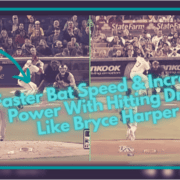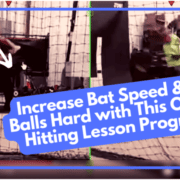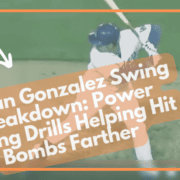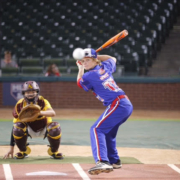Faster Bat Speed & Increase Power With Hitting Drills For Baseball & Softball Players Like Bryce Harper
Discover how to get faster bat speed and increase power with science-based hitting drills for baseball and softball players. Learn how in this Bryce Harper swing breakdown.
What Can Bryce Harper Learn From Mike Trout?
(PLEASE NOTE: this video post was done in 2014, before Bryce Harper won the NL MVP in 2015. At the end of the post I give an UPDATE)
This article explains why Mike Trout will repeatedly out-slug Bryce Harper mechanically, unless Bam-Bam adds efficiency to his swing.
I picked this match-up because they have one year separating their experience in the Big Leagues, they’re similar physically, but Mike Trout slugs almost 100 points higher! According to Baseball-Reference.com:
- Bryce Harper is 6’3″, 225 pounds,
- Mike Trout is 6’2″, 230 pounds,
- Harper’s 162-game average Slug% = .464, and
- Trout’s 162-game average Slug% = .554.
In this video, we’ll compare Mike Trout, and look at how Bryce Harper DOES NOT:
- Get a “head start” using Gravity,
- Spring load his body, and
- Follow the One-Joint Rule.
SCIENCE-BASED TRAINING:
Improve your hitting strategy dramatically by applying human movement principles.
Learn not only how and what to train but also the science behind the methods.
Mechanical Disadvantage #1: DOES NOT Get a “Head Start” Using Gravity
Bryce Harper starts from a dead stop. We know stop and go traffic burns fuel quicker than freeway driving. Because it’s inefficient. A “head start” is how we get more efficient during a swing. Think about receiving the baton in a 4X100 meter relay race. Throwing a 16-pound Shot Put over 70 feet. Or hitting a golf over 500 yards.
Effective hitters use Gravitational Forces to get their swing started and spice up their Final Turn. Mike Trout does this. Consider this Un-Weighting Principal test…
Imagine standing tall holding a forty-pound dumbbell in your hand hanging by your side. Now lift the weight up in front of your face. What muscles did you feel working? Shoulder? You’re right!
Now, get back to your standing position. Take a medium step forward and when your foot hits the ground, start to lift the dumbbell in front of your face. What muscles did you feel working? Would it be easier to lift that 40-pound dumbbell with the first or second scenario?
Mechanical Disadvantage #2: Minimal Spring Loading
Our body loads using springy fascial tissue. According to Thomas Myers in his book Anatomy Trains, fascia:
- Is what the bones and muscles float in,
- Gives muscles their shape,
- Is a spider web or cotton candy-like material, and
- Is made of mostly springy collagen fibers.
In comparing Adrian Gonzalez, Bryce Harper has an explosive swing, but in reality doesn’t engage his body’s own natural springy material as much as A-Gon.
Mechanical Disadvantage #3: DOES NOT Follow the One-Joint Rule
Dr. Kelly Starrett of MobilityWOD.com talks about this quite a bit. He’s referring to the head and spine position during dynamic movement. There are two types of vertebrae bending or flexing:
- Local Flexion – would be dropping the chin to the chest or ear to the shoulder, and
- Global Flexion – keeping the head and spine aligned as one unit, while bending forward or sideways.
In an efficient swing, number one is BAD, and number two is GOOD. Why? CLICK HERE and watch the next four minutes of this YouTube video (3:13-7:13) of Dr. Kelly Starrett demonstrating the One-Joint Rule. He doesn’t include flexing the head sideways (ear to shoulder). But you’d get the same ineffective force producing result as taking the chin to the chest.
As the above picture clearly shows, Bryce Harper actually goes ear to shoulder at and through contact. Unless something changes mechanically, “Bam-Bam” will continue to trail Mike Trout in repeatable power. However, with his body type, these changes can BOOST Harper into the 35+ homer per year category.
UPDATE: I wrote this article in 2014. Bryce Harper has made one big change to his mechanics…in this video, Carlos Pena and Shawn Casey points out some interesting points (not all I agree with):
Harper has changed some minor things. His leg kick isn’t quite so much of a kick anymore. He’s more grounded with his feet. He’s also tamed his head rolling sideways (breaking one-joint rule), but I still see it happen from time to time.
- Best Youth Baseball Hitting Program to Boost Rotational Power Fast—Trusted by MLB’s Rajai Davis & Built on the Catapult Loading System - June 22, 2025
- The #1 Arm Care Program for Youth Baseball: Why Top Travel Coaches Trust Jaeger’s J-Bands & Long Toss Routine to Prevent Injury Fast - June 3, 2025
- Are Baseball Hitting Lessons Worth It in 2025? Fix Your Kid’s Swing Fast With Pro-Approved Drills (Before You Waste Another $60) - May 29, 2025













Great video. With respect to showing the numbers, it looks like Harper goes from slightly open stance to near square at toe touch, while Trout and Gonzales go from square at set up to closed at toe touch. Is that the difference in showing the numbers. Also I had read that when hHarper was in the minors he used to move his head two feet during the swing (mostly horizontally). Sounds like he may have lunged more at the ball and maybe moved his head toward his front foot and not kept it centered. In your video it looks like he may have overcompensated that flaw by not moving his body much at all, though his head remains centered.
Whether a hitter starts open, squared, or closed they must lead with the front of their thigh (to the pitcher) and block the shoulders from opening until the front foot hits the ground. This is showing the numbers. We’re axial rotating the shoulders opposite the pelvis. The head can move all the way to landing (Fight Position), then once the pelvis gets the cue to open via Gravitational Forces, the head must not move at all. It becomes the axis of rotation along with the spine. When the head moves forward after landing, the axis of rotation gets thrown off similar to spinning a top, then flicking it slightly, sending it wobbling.
Another excellent presentation and some very astute observations Joey. Harper is a beast, but he’s making it very difficult for himself by standing there and hitting off his back side like that. He’s got to get off that back side much sooner. I like the way he’s digging in with the front heel, and his upper body rotational velocity is off the charts, but he’s not doing enough to take the weight off the bat (or his body) because he’s over-loading that back leg like that. It’s evident the more a person looks into it, that the forward momentum you teach is a MAJOR factor in hitting with power. Without that, you are late getting that back heel off the ground and you lose the ability to drive that back thigh forward. At that point you are disjointed because the bat is starting to come through. Your whole back side has to come forward (top and bottom), and your front side has to go back – at the same time and together! There has to be a synchronicity there, or your body will automatically tighten up to protect itself. You can’t bring the back shoulder forward without the front shoulder going back without folding up like a book. Bones don’t flex like that. Same thing for your pelvis. In order for the back side to come forward, the front side has to go back an equal distance. That’s where the axial rotation around the spine comes into play. You’ve shown that many times. Falling forward is not just to get the bat and your body moving to take the weight off it, which is the principle of motion called ‘Un-weighting’. When you allow your weight to move forward, you also, at the same time, roll off of that back heel, This is key to getting that front heel in position to drive the front side back, which in turn brings the back side forward. The human body moves in a reciprocating fashion. Upper/lower … left/right … front/back … etc. If you don’t coordinate and control reciprocating body segments, you will create what is called ‘Reciprocal inhibition’ which will rob, and leak power.
Bob, great comment. I love your description of equal and reciprocating forces. If there’s a disruption in these, then the brains tightens muscles to protect joints like you said. It seems whoever is steering Bryce Harper’s swing is causing him to “fight himself”. It’s very apparent and painful to watch him swing in slow motion right now. I believe he’s leaving 40% of his mechanical power on the table right now.
I agree with what you said here however I think the video of Bryce is not a good one to use as the camera is moving forward, it is also smaller so the movement effect is looks like is it less.
Mr. Jones, you’re absolutely correct!! I thought that too when doing analysis, but I didn’t want to make Bryce Harper’s mechanics look worse than they were. IF the camera shot still footage, then we’d see BH actually move forward during the Final Turn (NOT good). This I’ve seen him do time and time again in other footage and pictures. I took a clip that made him look good! Thanks for the catch.